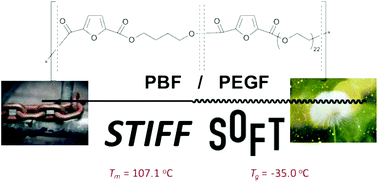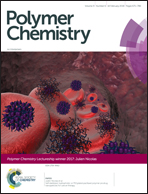Tailored design of renewable copolymers based on poly(1,4-butylene 2,5-furandicarboxylate) and poly(ethylene glycol) with refined thermal properties†
Abstract
In the recent years, search for innovative polymers derived from renewable resources resulted in an intense research and development of 2,5-furandicarboxylic acid-based polyesters. Special emphasis has been placed in high-performance polyesters, such as the poly(1,4-butylene 2,5-furandicarboxylate) (PBF)-based structures. In this study, both thermal and crystallisation-thermal properties of PBF have been enlarged simply by the incorporation of other renewable soft moieties in the polymer structure, namely, poly(ethylene glycol) (PEG) moieties. In particular, these novel copolymers can be designed to show some advantageous processing features as revealed by the lower melting temperature (in particular, it could be 107 °C) and higher thermal stability (up to 352–380 °C) as compared with PBF. Moreover, fast scanning calorimetric (FSC) studies of these novel copolymers indicated that crystallisation could be prevented even using relatively slow cooling rates (e.g., 0.1 °C s−1). The judicious selection and balance between hard PBF and soft PEG units enabled a segmented copolymer behaviour.



 Please wait while we load your content...
Please wait while we load your content...